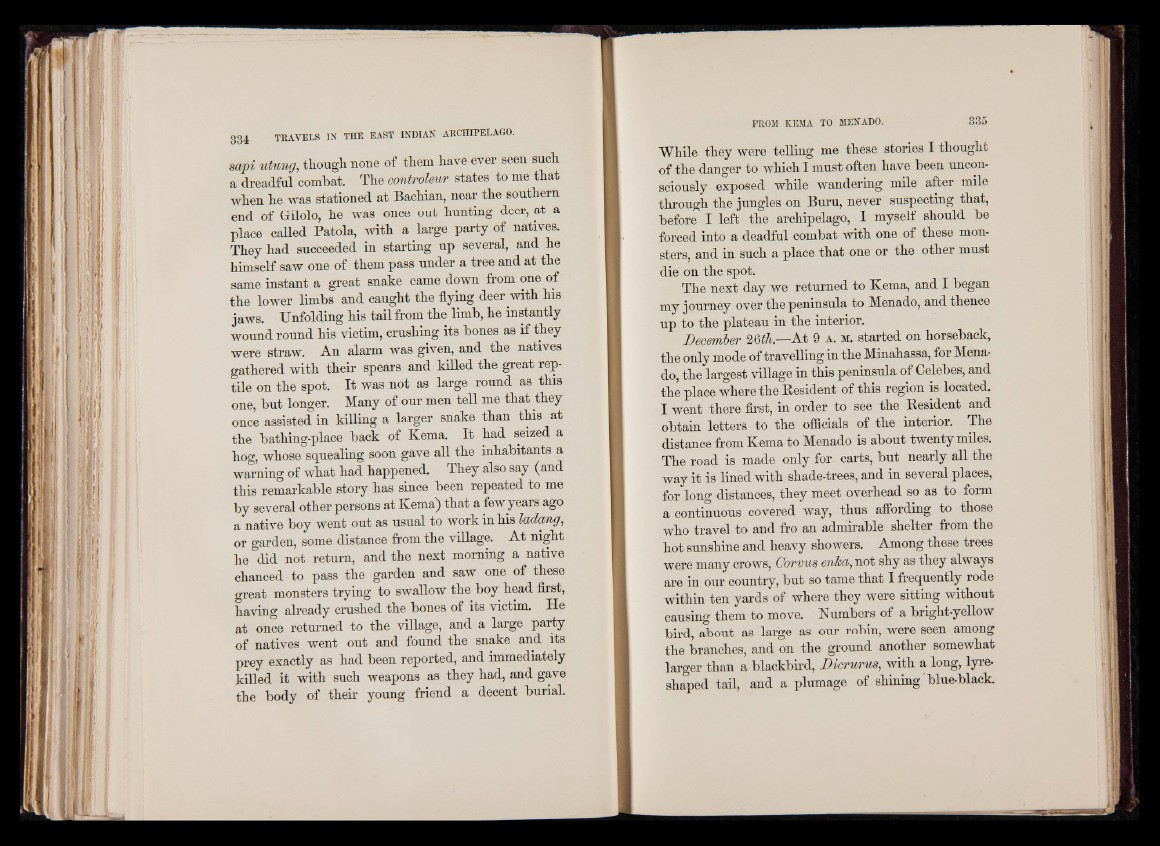
sapi utmng, though none of them have ever seen such
a dreadful combat. The conProleur states to me that
when he was stationed at Bachian, near the southern
end of Gilolo, he was once out hunting deer, at a
place called Patola, with a large party of natives.
They had succeeded in starting up several, and he
himself saw one of them pass under a tree and at the
same instant a great snake came down from one of
the lower limbs and caught the flying deer with his
jaws. Unfolding his tail from the limb, he instantly
wound round his victim, crushing its bones as if they
were straw. An alarm was given, and the natives
gathered with their spears and killed the great reptile
on the spot. It was not as large round as this
one, but longer. Many of our men tell me that they
once assisted in killing a larger snake than this at
the bathing-place back of Kema. It had seized a
hog, whose squealing soon gave all the inhabitants a
warning of what had happened. They also say (and
this remarkable story has since been repeated to me
by several other persons at Kema) that a fewyears ago
a native boy went out as usual to work in his ladcmg,
or garden, some distance from the village. At night
he did not return, and the next morning a native
chanced to pass the garden and saw one of these
great monsters trying to swallow the boy head first,
having already crushed the bones of its victim. He
at once returned to the village, and a large party
of natives went out and found the snake and its
prey exactly as had been reported, and immediately
killed it with such weapons as they had, and gave
the body of their young friend a decent burial.
While they were telling me these stories I thought
of the danger to which I must often have been unconsciously
exposed while wandering mile after mile
through the jungles on Buru, never suspecting that,
before I left the archipelago, I myself should be
forced into a deadful combat with one of these monsters,
and in such a place that one or the other must
die on the spot.
The next day we returned to Kema, and I began
my journey over the peninsula to Menado, and thence
up to the plateau in the interior.
December —At 9 a . m. started on horseback,
the only mode of travelling in the Minahassa, for Menado,
the largest village in this peninsula of Celebes, and
the place where the Resident of this region is located.
I went there first, in order to see the Resident and
obtain letters to the officials of the interior. The
distance from Kema to Menado is about twenty miles.
The road is made only for carts, but nearly all the
way it is lined with shade-trees, and in several places,
for long distances, they meet overhead so as to form
a continuous covered way, thus affording to those
who travel to and fro an admirable shelter from the
hot sunshine and heavy showers. Among these trees
were many crows, Corvus enka, not shy as they always
are in our country, but so tame that I frequently rode
within ten yards of where they were sitting without
causing them to move. Numbers of a bright-yellow
bird, about as large as our robin, were seen among
the branches, and on the ground another somewhat
larger than a blackbird, Dicrurus, with a long, lyreshaped
tail, and a plumage of shining blue-black.